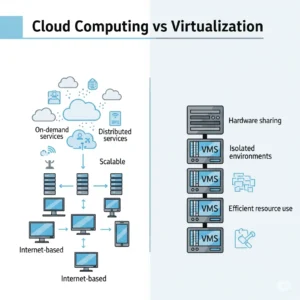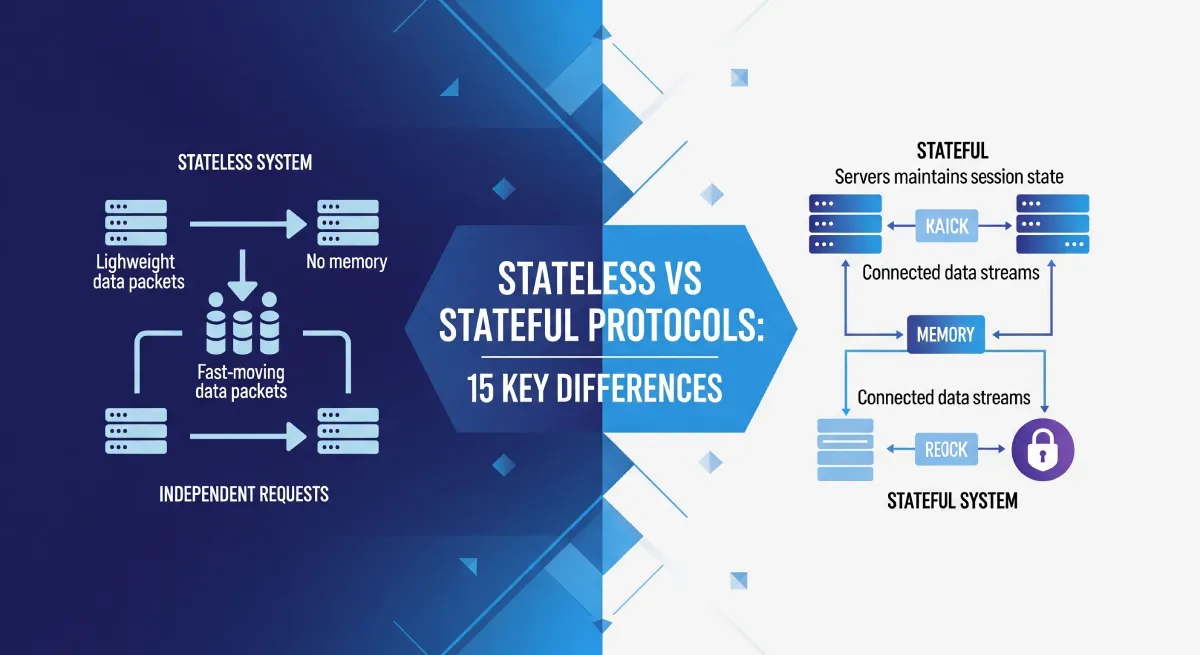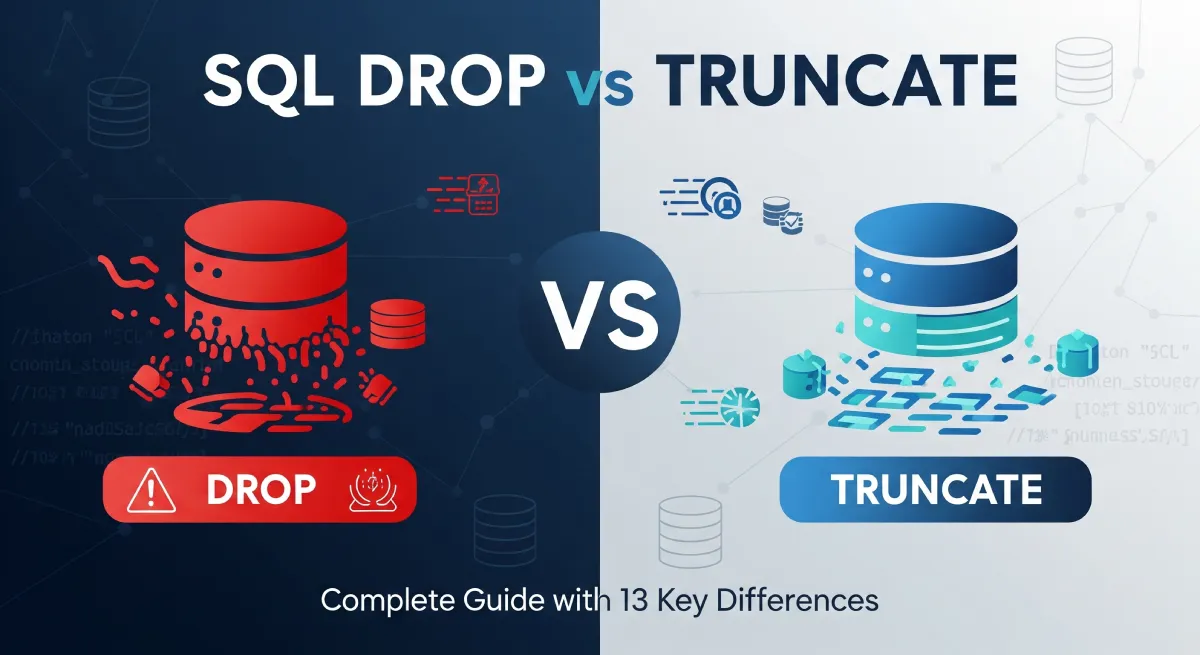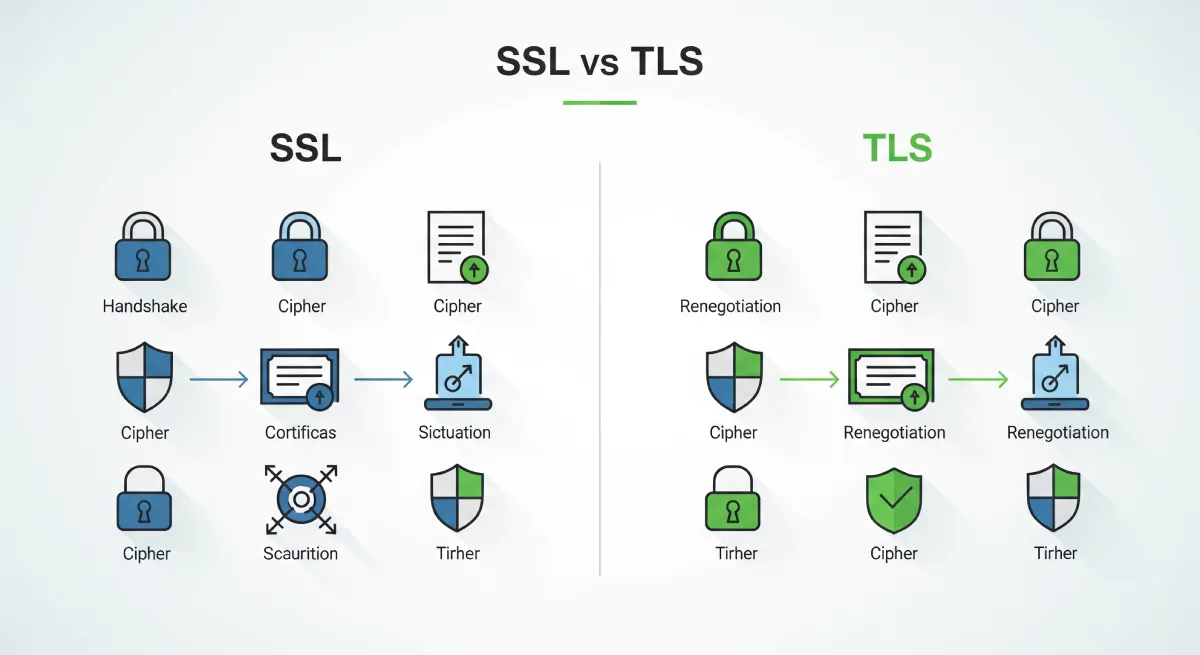Introduction
Modern businesses face a constant challenge: how to manage their IT infrastructure efficiently while keeping costs under control. Two technologies have emerged as game-changers in this space: cloud computing and virtualization.
While these terms are often used interchangeably, they serve different purposes and solve distinct problems. Understanding their differences can help you make informed decisions about your organization’s technology strategy.
In this comprehensive guide, we’ll break down both technologies, compare their benefits and drawbacks, and help you determine which approach best fits your specific needs.
What is Cloud Computing?
Cloud computing transforms how we access and use technology resources. Instead of purchasing and maintaining physical servers, businesses can rent computing power, storage, and software applications over the internet.
Think of it like subscribing to electricity from a utility company rather than installing your own power generator. You pay only for what you use, and someone else handles the maintenance and infrastructure.
Key Benefits of Cloud Computing
- Instant Scalability: Need more storage or computing power? Scale up in minutes, not weeks.
- Global Accessibility: Access your applications and data from anywhere with internet connection.
- Cost Efficiency: Eliminate upfront hardware investments and reduce operational expenses.
- Automatic Updates: Your cloud provider handles software updates and security patches.
- Disaster Recovery: Built-in backup and recovery options across multiple geographic locations.
Potential Drawbacks
- Internet Dependency: Poor connectivity can disrupt your operations.
- Data Security Concerns: Storing sensitive information with third-party providers requires careful consideration.
- Ongoing Costs: Monthly subscription fees can add up over time.
- Limited Control: Less customization options compared to on-premises solutions.
Popular Cloud Computing Services
Major cloud providers include Amazon Web Services (AWS), Microsoft Azure, Google Cloud Platform, and IBM Cloud. These platforms offer three main service models:
- Infrastructure as a Service (IaaS): Rent virtual servers and storage
- Platform as a Service (PaaS): Development platforms and tools
- Software as a Service (SaaS): Ready-to-use applications like Gmail or Salesforce

What is Virtualization?
Virtualization is like creating multiple apartments within a single building. It allows you to run several virtual computers (called virtual machines) on one physical server, each operating independently.
This technology maximizes hardware utilization by dividing physical resources among multiple virtual environments. Each virtual machine can run its own operating system and applications without interfering with others.
Key Benefits of Virtualization
- Resource Optimization: Get more value from your existing hardware investments.
- Environment Isolation: Separate applications and services for improved security and stability.
- Quick Deployment: Create new virtual machines in minutes rather than ordering new hardware.
- Cost Reduction: Fewer physical servers mean lower electricity, cooling, and space costs.
- Easy Backup: Virtual machines can be backed up and restored quickly.
Potential Challenges
- Performance Overhead: Virtual machines use slightly more resources than physical ones.
- Management Complexity: Monitoring multiple virtual environments requires specialized tools.
- Single Point of Failure: If the physical server fails, all virtual machines on it go down.
- Licensing Costs: Some software licenses become more expensive in virtualized environments.
Common Virtualization Technologies
Popular virtualization platforms include VMware vSphere, Microsoft Hyper-V, Citrix XenServer, and open-source solutions like KVM and VirtualBox. Container technologies like Docker and Kubernetes also fall under the virtualization umbrella.
Key Differences: Cloud Computing vs Virtualization
Scope and Purpose
Cloud computing is a service delivery model that provides access to computing resources over the internet. Virtualization is a technology that enables this service delivery by maximizing hardware efficiency.
Ownership and Control
With cloud computing, you rent resources from a service provider. With virtualization, you typically own and manage the physical hardware yourself, even though you’re running virtual machines on it.
Scalability Approach
Cloud computing offers near-instant scalability – you can add resources with a few clicks. Virtualization scalability is limited by your physical hardware capacity.
Cost Structure
Cloud computing follows an operational expense (OpEx) model with monthly fees. Virtualization requires upfront capital investment (CapEx) in hardware and software licenses.
Technical Implementation
Cloud computing relies on virtualization as its foundation, but adds layers of automation, orchestration, and service management. Virtualization focuses primarily on resource abstraction and isolation.
Side-by-Side Comparison
Aspect | Cloud Computing | Virtualization |
|---|---|---|
| Primary Function | Delivers computing services over the internet | Creates virtual instances on physical hardware |
| Scalability | Instant scaling up or down based on demand | Limited by physical hardware capacity |
| Cost Model | Pay-as-you-go subscription model | Upfront hardware and software investment |
| Accessibility | Access from anywhere with internet | Typically limited to local network access |
| Maintenance | Provider handles infrastructure maintenance | Organization responsible for hardware maintenance |
| Data Location | Stored in provider’s data centers | Stored on organization’s premises |
| Internet Dependency | Requires stable internet connection | Can operate without internet (local access) |
| Disaster Recovery | Built-in across multiple geographic locations | Requires separate backup and recovery planning |
Implementation Guide
When to Choose Cloud Computing
Cloud computing works best for organizations that need:
- Rapid scaling capabilities for growing businesses
- Remote access for distributed teams
- Reduced IT management overhead
- Lower upfront costs
- Built-in disaster recovery and backup
When to Choose Virtualization
Virtualization is ideal for organizations that require:
- Complete control over their infrastructure
- Compliance with strict data location requirements
- Optimization of existing hardware investments
- Isolated testing and development environments
- Predictable, controlled costs
Getting Started with Cloud Computing
- Assess Your Needs: Identify which applications and data can move to the cloud
- Choose a Provider: Compare AWS, Azure, Google Cloud based on your requirements
- Start Small: Begin with non-critical applications to gain experience
- Plan Migration: Develop a phased approach to move existing systems
- Monitor Usage: Track costs and performance to optimize your cloud investment
Implementing Virtualization
- Hardware Assessment: Ensure your servers have sufficient CPU, memory, and storage
- Choose Hypervisor: Select between VMware, Hyper-V, or open-source options
- Plan VM Layout: Design your virtual machine architecture
- Install and Configure: Set up the virtualization platform
- Create Virtual Machines: Deploy and configure your virtual environments
- Implement Monitoring: Set up tools to track performance and resource usage
Best Practices and Optimization Tips
Cloud Computing Best Practices
- Right-Size Resources: Regularly review and adjust instance sizes to match actual usage
- Use Auto-Scaling: Configure automatic scaling to handle traffic spikes efficiently
- Implement Cost Controls: Set up billing alerts and budget limits
- Leverage Managed Services: Use provider-managed databases and services to reduce operational overhead
- Plan for Security: Implement encryption, access controls, and regular security audits
Virtualization Best Practices
- Monitor Resource Usage: Keep CPU, memory, and storage utilization below 80%
- Plan for Growth: Leave room for expansion when sizing virtual machines
- Implement Backup Strategy: Regular backups and tested recovery procedures
- Use Templates: Create standardized VM templates for consistent deployments
- Network Segmentation: Isolate different types of workloads for security
Common Pitfalls to Avoid
- Overprovisioning: Don’t allocate more resources than needed
- Neglecting Security: Both cloud and virtualized environments need proper security measures
- Ignoring Costs: Monitor spending regularly to avoid bill shock
- Poor Planning: Inadequate capacity planning can lead to performance issues
- Vendor Lock-in: Design systems to maintain flexibility across platforms
Frequently Asked Questions
Can cloud computing and virtualization work together?
Absolutely! Cloud computing actually relies heavily on virtualization technology. Cloud providers use virtualization to maximize their hardware efficiency and provide flexible resource allocation to customers. Many organizations use both technologies – virtualization for on-premises infrastructure and cloud computing for additional capacity or specific services.
Which is more secure: cloud computing or virtualization?
Both can be equally secure when properly implemented. Cloud providers invest heavily in security infrastructure and employ dedicated security teams. However, with virtualization, you maintain complete control over your security measures. The choice depends on your specific security requirements and compliance needs.
How do costs compare between cloud and virtualization?
Cloud computing typically has lower upfront costs but higher ongoing expenses. Virtualization requires significant initial investment but lower operational costs over time. The total cost of ownership depends on your usage patterns, growth projections, and how long you plan to use the technology.
Can small businesses benefit from these technologies?
Yes! Small businesses often benefit more from cloud computing due to lower upfront costs and reduced IT management requirements. Virtualization can be beneficial for small businesses with existing hardware that want to maximize their investment.
What happens to my data if I want to switch providers or technologies?
Data portability depends on your planning and the technologies you choose. Always ensure you have data export capabilities and avoid proprietary formats that could create vendor lock-in. Most reputable providers offer migration tools and support to help with transitions.
Do I need IT expertise to implement these technologies?
While some technical knowledge is helpful, many cloud services are designed for non-technical users. Virtualization typically requires more technical expertise for setup and management. Consider your team’s capabilities and whether you might need external support or training.
Final Thoughts
The choice between cloud computing and virtualization isn’t always either/or. Many successful organizations use both technologies strategically, leveraging virtualization for on-premises infrastructure optimization and cloud computing for scalability and innovation.
Consider your specific needs:
- Choose cloud computing if you need rapid scaling, global accessibility, and want to minimize IT management overhead
- Choose virtualization if you need complete control, have specific compliance requirements, or want to optimize existing hardware investments
- Use both for a hybrid approach that combines the benefits of each technology
The key is to start with a clear understanding of your business requirements, evaluate your technical capabilities, and choose the approach that best aligns with your goals and budget. Both technologies continue to evolve, so staying informed about new developments will help you make the best decisions for your organization’s future.



